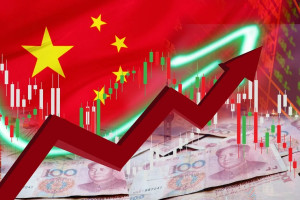China is on track to surpass the United States as the world’s largest economy by 2045, said Prof. Justin Yifu Lin, former Chief Economist at the World Bank.
Speaking at the Investor Daily Summit (IDS) 2025 in Jakarta on Wednesday, October 8, 2025, Prof. Lin offered valuable insights into the forces driving China’s rise and the implications of these developments on global economic dynamics.
In his address, Prof. Lin − known for his accurate predictions on China’s economic growth − discussed how China’s rapid economic expansion has reshaped the global economic order over the past few decades. Since the early 2000s, China’s contribution to the global GDP has surged from just 6.9 percent in 2000 to 16.8 percent by 2018, with projections indicating this growth will continue to accelerate in the coming decades.
“The driving factors behind this rise are multifaceted,” he said. “China’s strategic industrial policies, investment in innovation, and an ever-expanding domestic market have been key in propelling its economy forward.”
With a population of 1.4 billion people, China’s sheer size provides an unparalleled advantage in terms of labor force, consumption potential, and economic production capacity.
China’s rise has not only been driven by domestic factors but also its increasing role in global trade and investment. “The Belt and Road Initiative (BRI) and China’s growing presence in international trade agreements have allowed the country to build stronger economic ties with developing and developed nations alike,” Prof. Lin noted.
Decline of U.S. dominance
While China’s growth is impressive, it is equally important to note the relative decline of the United States’ share in global GDP. From controlling nearly 47 percent of the world’s GDP in 2000, the U.S. now accounts for just 13.7 percent as of 2018.
Prof. Lin argued that this significant decrease in the U.S.’s economic share, which had long been the cornerstone of global economic governance, signals the end of an era.
“Throughout the 20th century, the United States was the largest economy in the world. But over the past two decades, we have seen an undeniable shift,” he said. “The rise of emerging economies, particularly China, has played a major role in this transformation.”
Road to 2045
Looking ahead, Prof. Lin outlined a clear path for China to become the largest economy in the world by 2045. If the current trends continue, China’s economic growth could outpace that of the U.S. due to several key factors: the ongoing expansion of its industrial base, the increasing sophistication of its technology sector, and the sheer scale of its domestic market.
“If China’s GDP reaches half the level of the United States by 2045, its economy will be twice the size of the U.S. in terms of total economic output,” he said.
He pointed out that China’s economic size will be magnified by the fact that its population is four times larger than that of the U.S., offering it an undeniable advantage in terms of consumption and production.
A new economic order
The shift in economic power from the U.S. to China is not just a matter of numbers but also signifies a fundamental change in the global economic order. As China’s economy continues to grow, so too will its influence in international markets, geopolitics, and technological advancements.
Prof. Lin emphasized that in the coming decades, China’s technological capabilities and industrial development will likely rival, and in some areas surpass, those of the United States.
“This is a shift that will redefine industries, reshape global supply chains, and alter the balance of economic and political power worldwide,” he noted, while citing the fact that China is increasingly positioned at the forefront of next-generation industries such as artificial intelligence, renewable energy, and advanced manufacturing.
With this, China’s growing economic power could have far-reaching effects on global trade patterns, leading to new trade relationships and alliances. The U.S. will no longer hold the same advantages in global commerce and technological leadership, creating a more multipolar world economy.
U.S.-China tensions and geopolitical implications
While praising China’s rise, Prof. Lin also acknowledged the increasing tensions between the U.S. and China. Since the early 21st century, the U.S. has sought to contain China’s growth through measures like the “Pivot to Asia” policy, trade wars, and efforts to decouple the two economies. The recent technological battle between the two nations, particularly in sectors like semiconductors and telecommunications, reflects the intense competition between them.
“China’s rise to global economic prominence has led to rising geopolitical tensions, especially with the U.S. trying to safeguard its dominant position,” he observed.
The economic and technological rivalry between the two nations, while fueling innovation, is also creating significant friction in the global market.
Prof. Lin emphasized that the U.S. has adopted a “containment” strategy to slow China’s progress, but this may only delay, rather than prevent, China from overtaking the U.S. economically in the long run.
The future of global economic leadership
With these dynamics at play, Prof. Lin warned that the global economy is entering an uncertain period of transition. The future will likely see the emergence of a new economic order, where multiple nations and regions, rather than just the U.S. and China, will share economic leadership.
Prof. Lin’s remarks at the IDS 2025 serve as a reminder of the changing global economic landscape. China’s rise presents a complex challenge to the existing world order, and its future economic dominance may redefine the way nations interact in the global marketplace. While tensions and uncertainties abound, the shift in economic power is inevitable, and the world must adapt to the new dynamics of this rapidly changing era.
“We are witnessing the dawn of a new era in the global economy − one that will be characterized by a more balanced distribution of power and influence,” he concluded.
